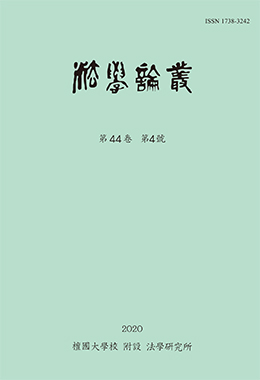본 논문에서는 “대법원 2019.1.17, 선고 2018다245702 판결”의 손해배상청구권에 있어 판례를 중심으로, 상법 제724조 제2항에 의한 직접청구권의 법적성질에 대하여 알아보았으며, 또한 위 논고에서 제3자의 직접청구권의 법적성질에 대하여 피해자에게 가해자 또는 책임을 질 사고로 피보험자가 입은 손해에 대하여 보험금 약정 한도 내에서 보험자에게 직접 청구할 수 있도록 한 규정에 대하여 대법원 판례는 어떠한 입장을 보이고 있는가에 대하여 알아보았다.
그러나 판례는 보험자와 피보험자는 공제계약에 따라 손해배상채무에 대하여 보험자와 피보험자가 병존적 채무인수 한 보험이므로 보험자와 피보험자의 손해배상채무는 연대채무관계에 있다는 것을 알 수 있다.
상법 제724조 제2항에 의하여 피해자에게 인정되는 직접청구권의 법적 성질은 보험자가 피보험자의 피해자에 대한 손해배상 채무를 병존적 채무인수한 것으로서 피해자가 보험자에 대하여 가지는 손해배상 청구권임을 또한 알 수 있다.
그런가 하면 판례는 손해배상청구권설과 보험금청구권설의 입장에서 설명하고 있음을 보이고 있다. 하지만 학설에서 다툼이 있지만 위 판례는 손해배상청구권설에 따르고 있음을 알 수 있으며, 이는 가급적 책임보험이 제3자를 보호해야 한다는 것을 나타내고 있다.
이처럼 이 논문에서 살펴보고자 하는 것은 우리 대법원 판례는 보험자가 피보험자의 피해자에 대한 손해배상채무에 있어 보험자는 그 채무를 병존적 채무인수 한 것으로 보고 있으며, 보험자의 직접청구권은 보험금청구권의 변형이나 이에 준하는 권리가 아니라고 판시하고 있음을 알 수 있다. 하지만 선고 판결에 의하여 내려진 판결문을 살펴보면 법원이 이러한 판단을 내리게 된 어떠한 근거나 판단의 합리적 당위성에 대해서는 전혀 언급이 없어 판결의 그 타당성에 의구심이 들지만, 분명한 것은 손해배상청구권설의 직접청구권에 있어서 그 직접청구권은 보험자가 피보험자의 손해배상채무를 병존적 채무인수 한 것으로 보고 있다. 그러므로 피보험자와 보험자는 동일한 채무를 부담하고 있는 연대채무관계임을 명시하고 있다는 것을 알 수 있다.
또한 상법 제724조의 문제가 되는 직접청구권의 법률적용 문제에 있어서도 다양한 요소를 고려하여 문제를 해결하여야 할 것이다.
In this paper, the legal nature of the direct claim under Article 724 (2) of the Commercial Act was investigated, focusing on precedents in the right to claim damages in the Supreme Court 2019, January 17, 2018 Da245702 judgment.
In addition, in the above article, the Supreme Court precedent regarding the regulation that allows the insurer to directly claim damages incurred by the insured in the event of an accident that would cause the victim to be liable or the perpetrator for the legal nature of the third party’s direct claim right, within the limit of the insurance payment agreement. We checked whether it is showing.
However, the precedent is that the insurer and the insured have a joint liability relationship between the insurer and the insured because it is an insurance that the insurer and the insured acquired concurrently with respect to the damages liability according to the deduction contract.
It can also be seen that the legal nature of the right to claim direct claims recognized by the victim pursuant to Article 724 (2) of the Commercial Act is that the insurer has concurrently taken over the insured’s liability for damages against the victim, and that the victim has the right to claim damages against the insurer. On the other hand, it shows that the precedent is being explained in terms of the right to claim damages and the right to claim insurance money. However, although there are disputes in the theory, it can be seen that the above precedent is in accordance with the right to claim damages, which indicates that liability insurance should protect third parties as much as possible. As such, it is intended to report that the case of the Supreme Court of Korea is that the insurer has taken over the insurer’s liability for damages against the insured’s victim in parallel, and the insurer’s direct claim is a modification of the insurance claim right or equivalent.It can be seen that it is judged not to be a right. However, when looking at the judgment issued by the sentencing judgment, there is no mention of any grounds for which the court made this judgment or the reasonable justification of the judgment. Obviously, in the direct claim for the right to claim damages, the direct claim is regarded as the insurer’s coexistence of the insured’s liability for damages.
Therefore, it can be seen that the insured and the insurer stipulate that it is a joint debt relationship that bears the same debt In addition, in the matter of applying the law of direct claim, which is a problem under Article 724 of the Commercial Act, the problem must be resolved by considering various factors.




